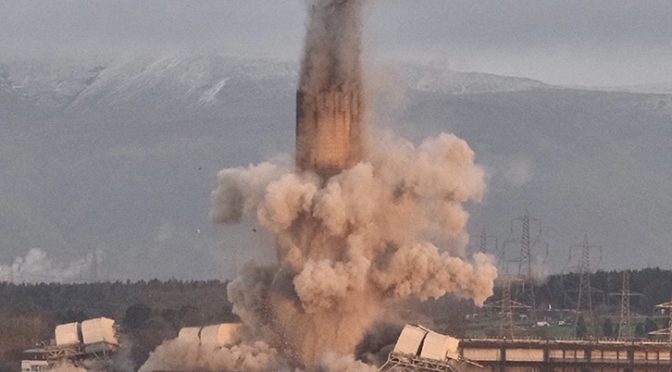Scotland’s First Minister, Nicola Sturgeon, pressed the button that activated the 700 kg of explosives that brought down what was until today the tallest free-standing structure in the country. It is the chimney of the Longannet power station, once the largest coal-fired power station in Europe.
Scotland has been coal-free since ScottishPower – Iberdrola’s UK subsidiary – closed the plant in 2016. ScottishPower is also the first integrated energy company in the UK to have 100% green electricity generation.
Ignacio Galán, Chairman of Iberdrola, said: “Longannet played an important role in Scotland’s history as its largest coal-fired power station, but the future can only be clean energy. Everyone in the Iberdrola group should be proud to contribute to this impressive transition from fossil fuels to renewables”.
“This transition is essential to minimise the worst impacts of global warming and address the climate emergency. In Glasgow we have made significant progress, but it is time for all countries to commit to making coal history. Fine words or promises about 2040 or 2050 are no longer enough, we need delivery. Iberdrola will continue to invest billions of euros in renewables, smarter grids and storage to become net zero in Europe by 2030, providing abundant and competitive electricity and creating opportunities for industrial development and employment across the value chain.”
At COP26 in Glasgow Iberdrola already made clear how proud it was as a company to show the world what Scotland has already done with coal.
Scotland’s First Minister, Nicola Sturgeon, described today’s event as a symbolic moment: “We have ended coal-fired power generation in Scotland”.
Longannet power station, located in Kincardine-on-Forth (Fife), began generating electricity in 1970. It was the largest coal-fired power station in Europe when it was built and remained so in Scotland until ScottishPower closed it on 31 March 2016. Thus, guaranteeing Scotland’s coal-free future, it ended 47 years of fossil fuel production that supplied two million Scottish households.
Prior to the demolition event and in the wake of COP26 in Glasgow and its ‘Climate Pact’ to move the world away from fossil fuels, the stripes of global warming were projected onto the chimney along with the slogan Make Coal History. This is a call to action for other countries to follow Scotland’s example.
Created by Professor Ed Hawkins of the University of Reading, the stripes show the change in global temperature from 1850 to 2020. They range from shades of blue, representing cooler than average years, to red, representing warmer than average years.
The Iberdrola subsidiary is the only integrated energy company in the United Kingdom that generates 100% green electricity from offshore and onshore wind power. As a major partner of the United Nations Climate Change Conference COP26, ScottishPower is committed to supporting the UK’s efforts to reduce coal consumption across the country.
Pioneers in energy transition
At the end of 2017, Iberdrola requested authorisation to close its last thermal power plants in the world – Velilla (Palencia) and Lada (Asturias) – in response to its decision to replace CO2-emitting facilities with the latest generation of clean energy and thus lead the energy transition towards a new sustainable energy model.
Iberdrola continues to advance in its sustainability strategy, based on the electrification of the economy and oriented towards the fight against climate change and the creation of wealth and employment in the communities where it operates.
Its own CO2 emissions as of September have been reduced to 53 g/kWh and it maintains its goal of becoming an emission-neutral company by 2030 in Europe.
In the last two decades, the company has invested 120 billion euros in renewable energies, smart grids and energy storage. Its 2030 investment plan of €150 billion will enable it to triple its renewable capacity to almost 100,000 MW.


